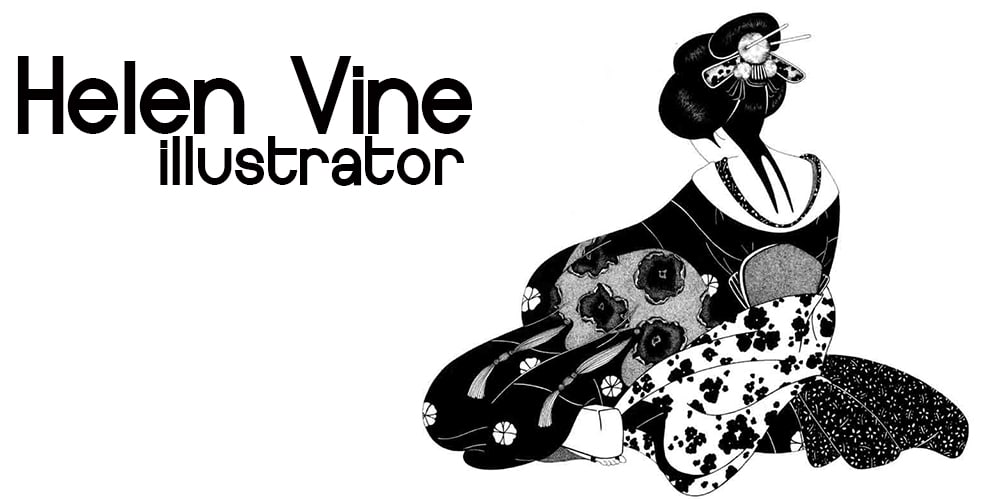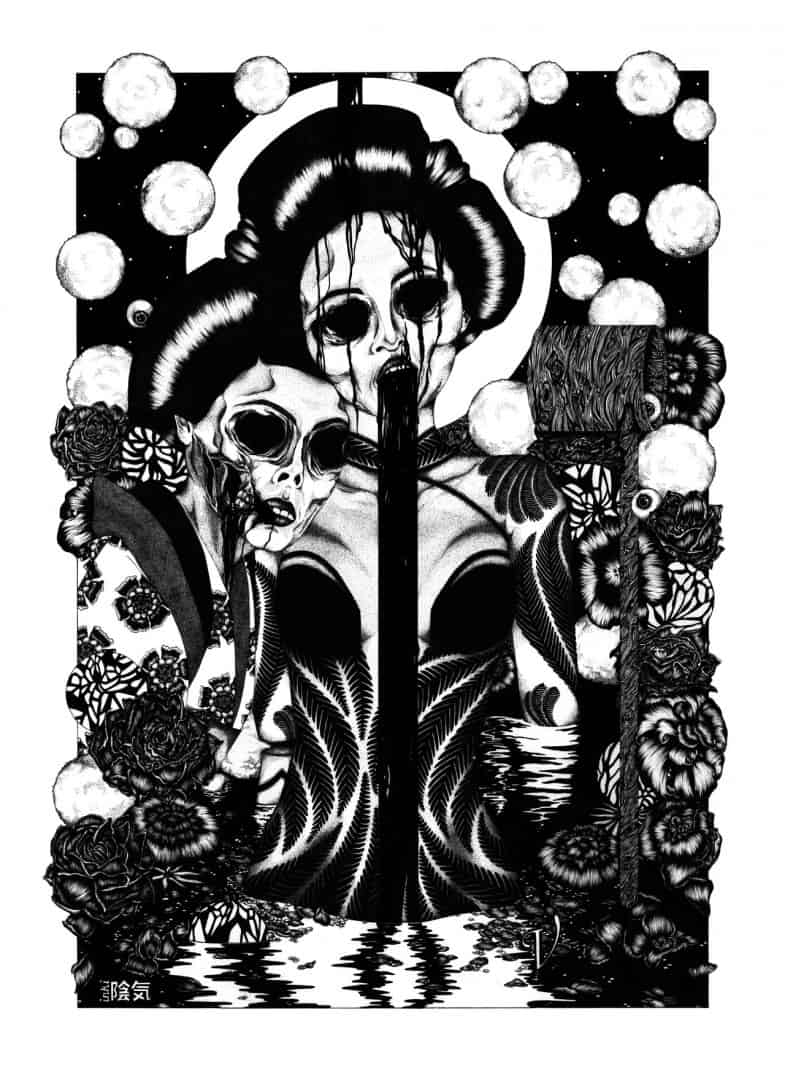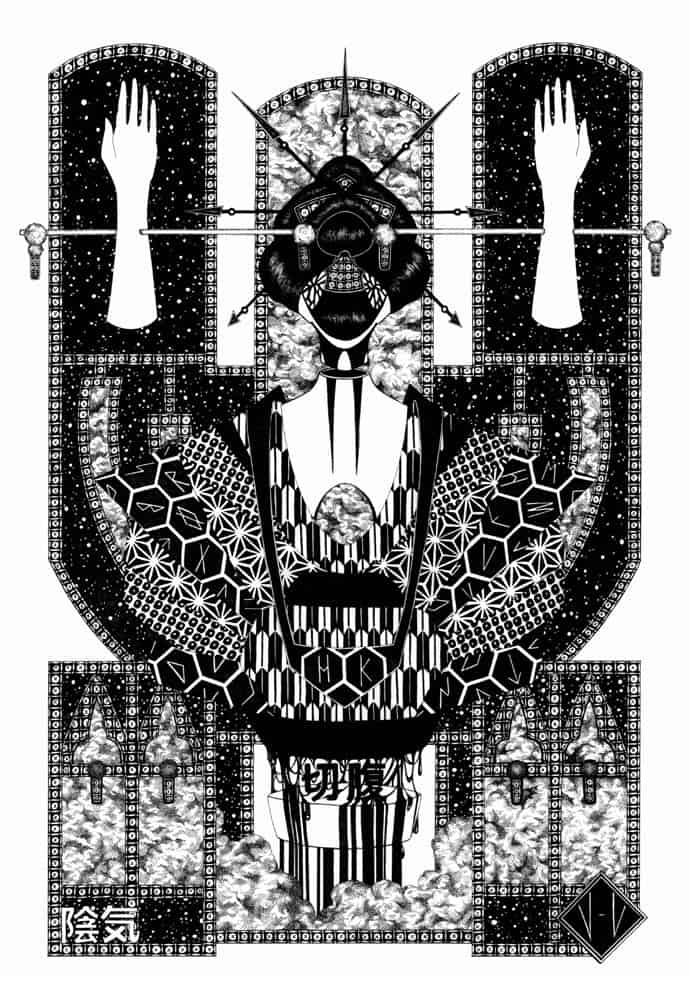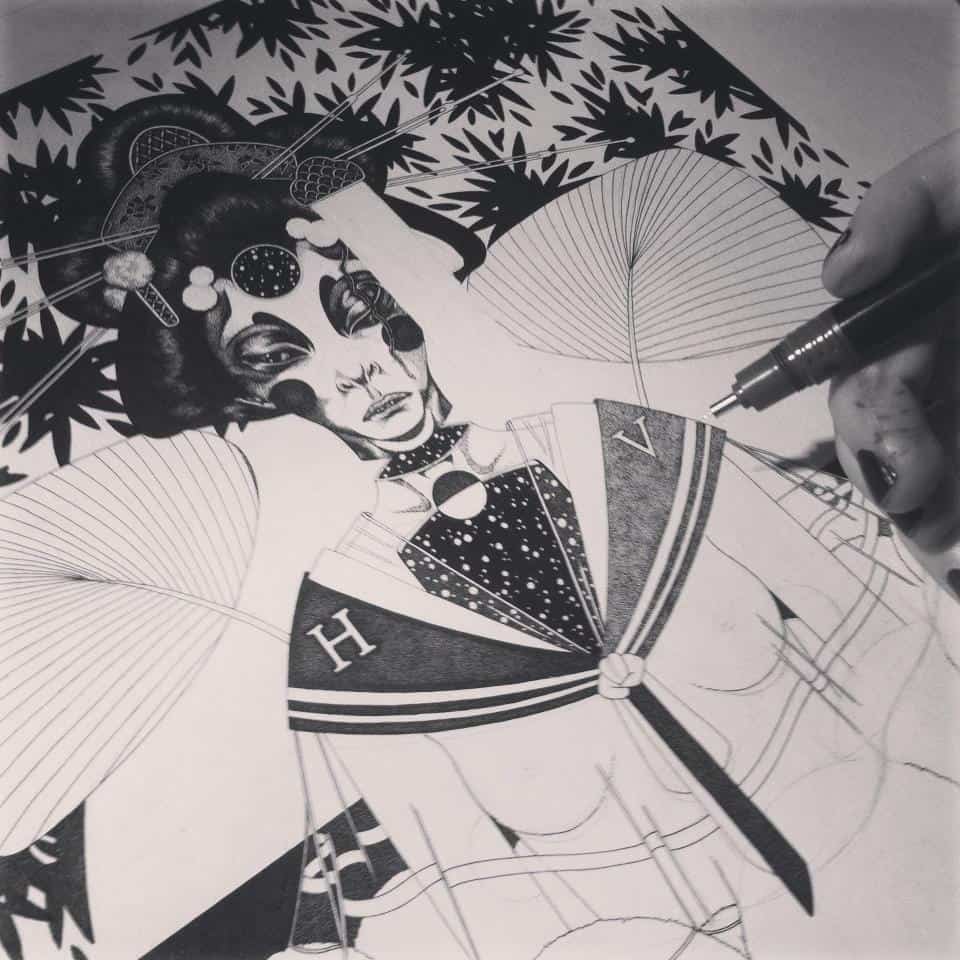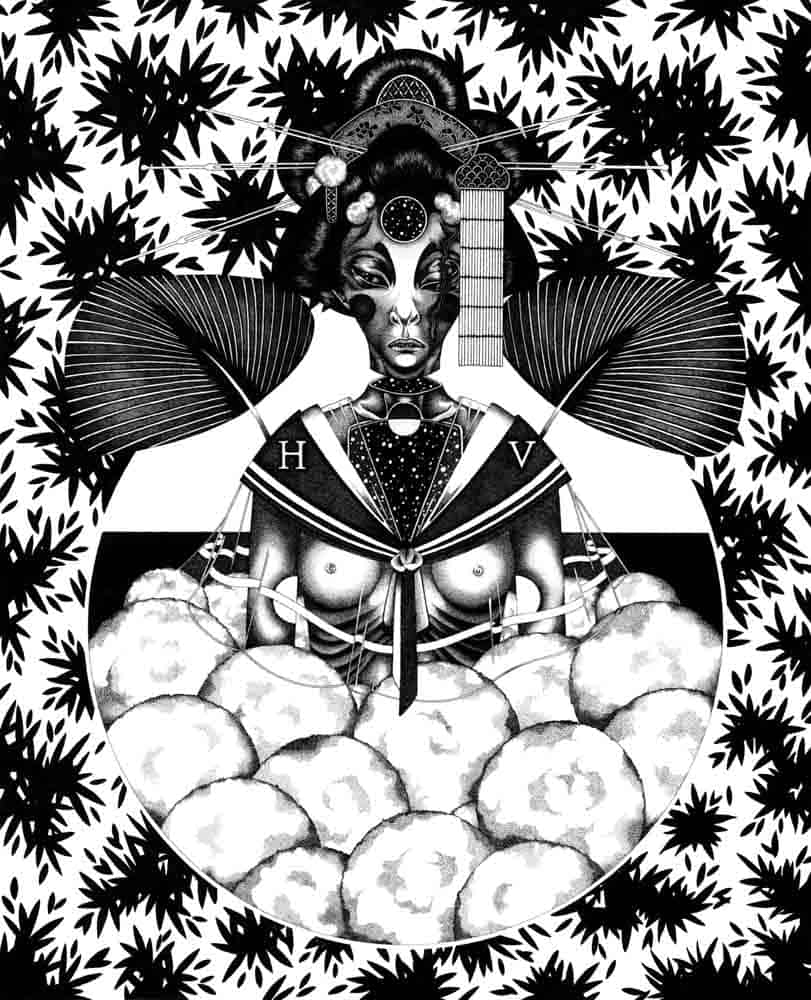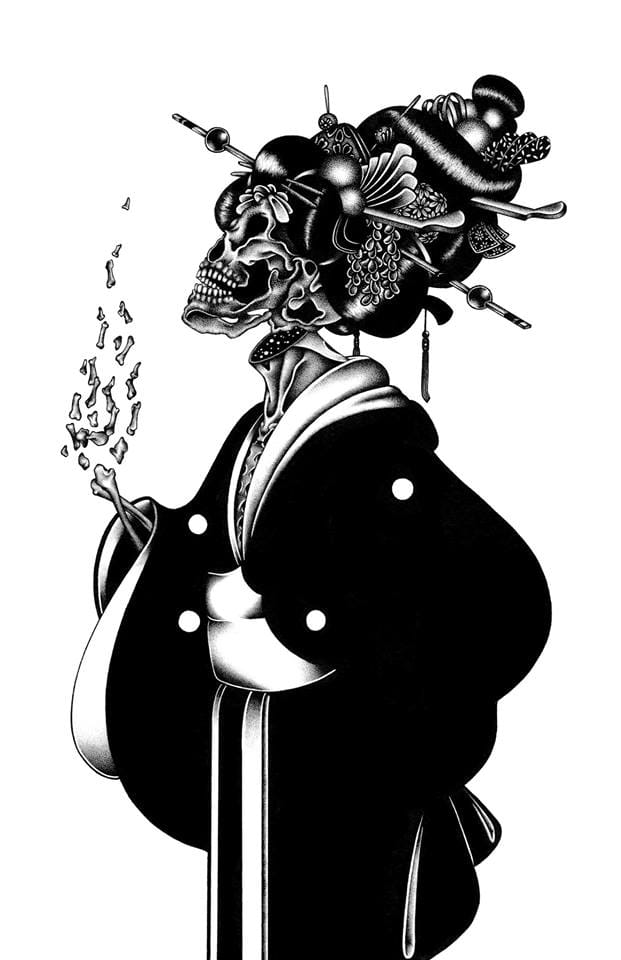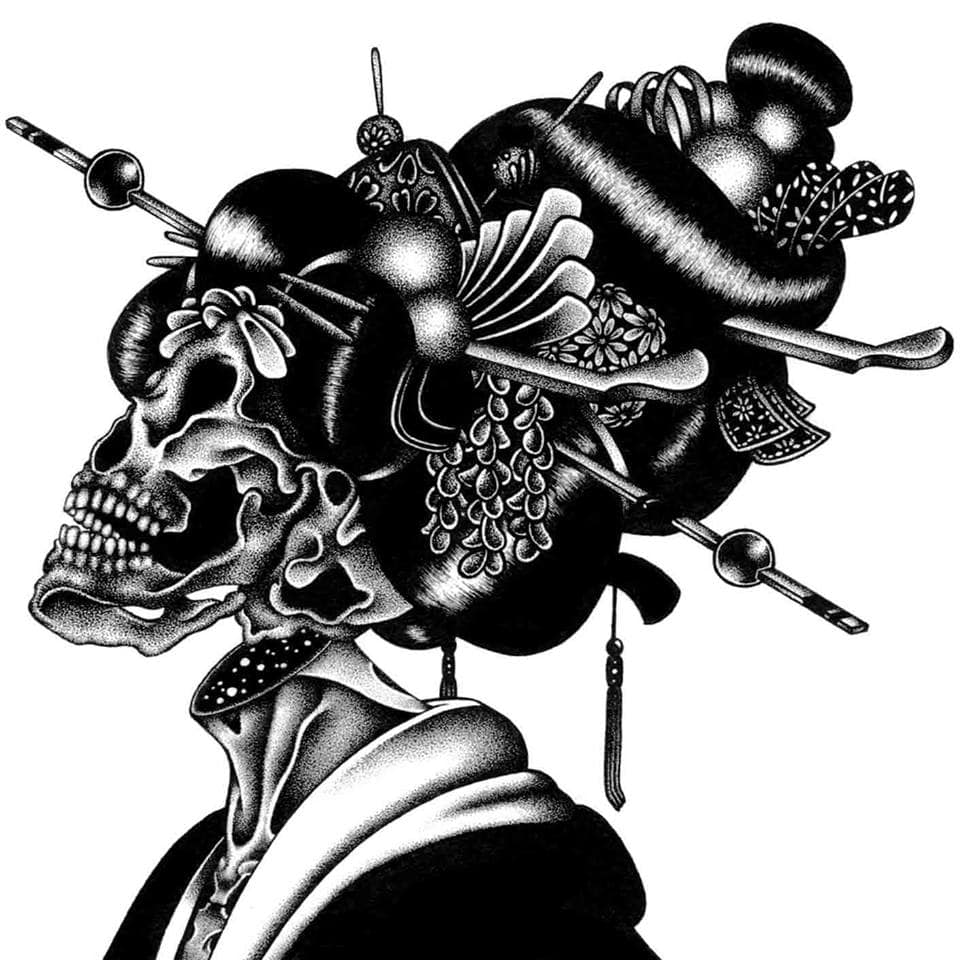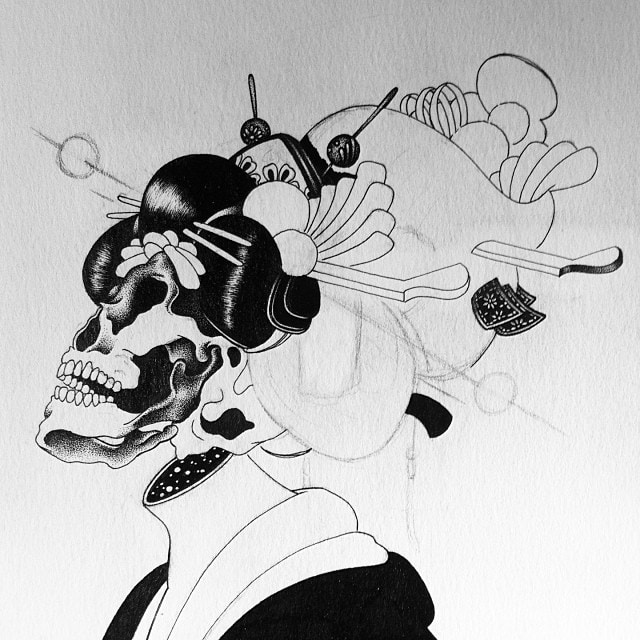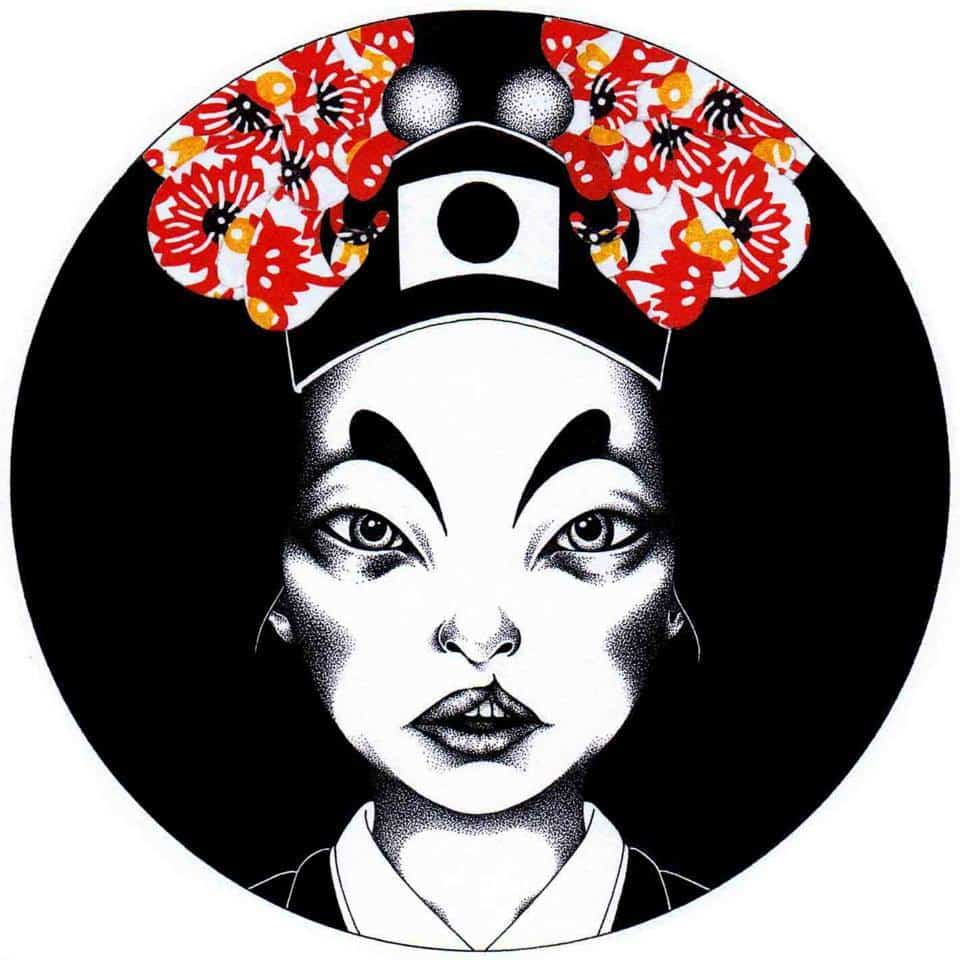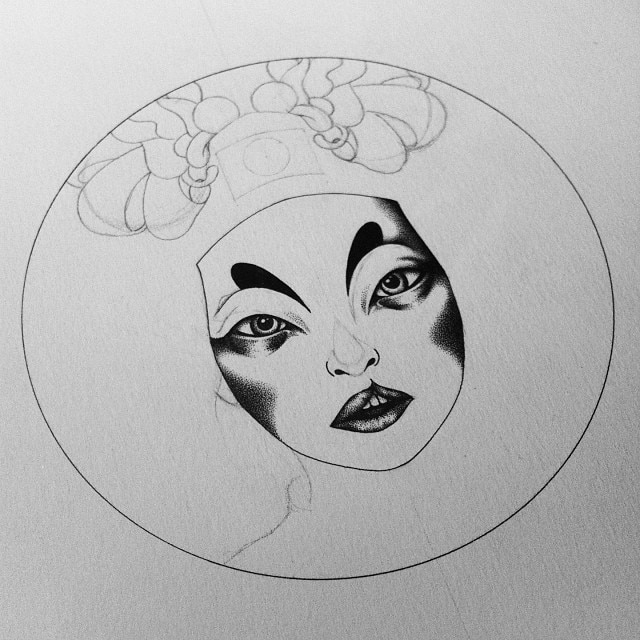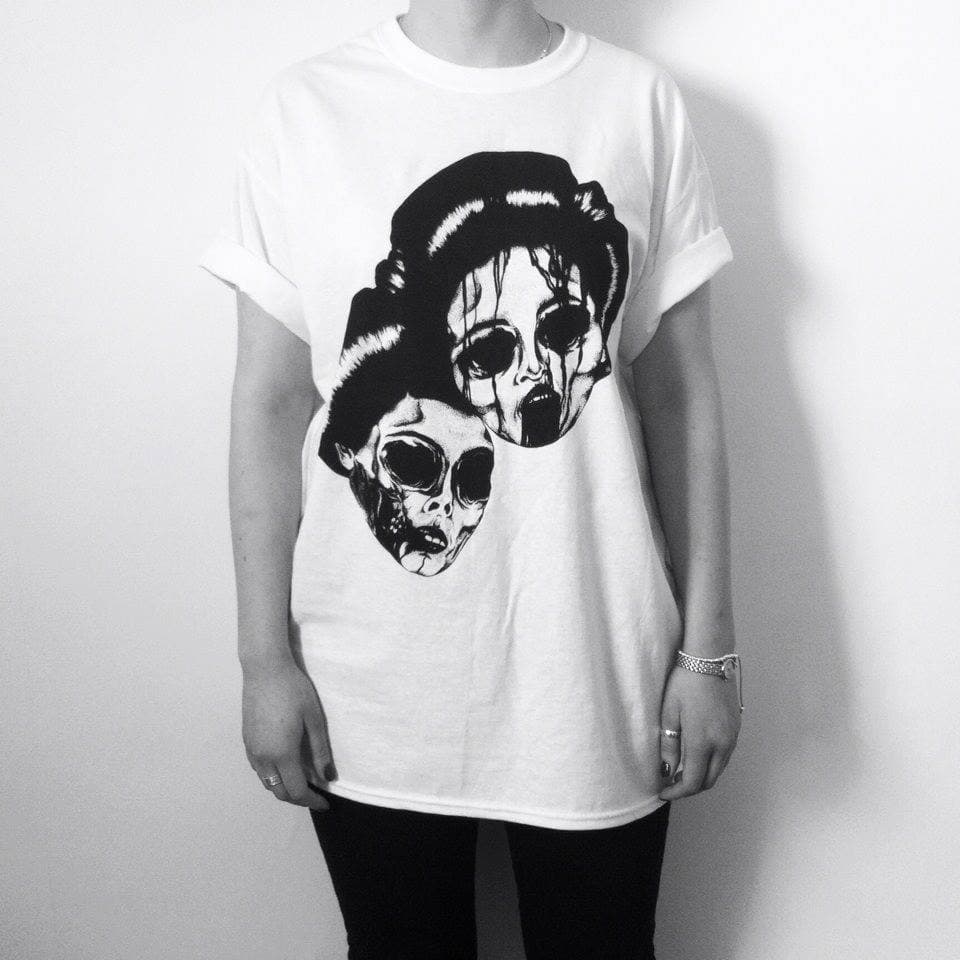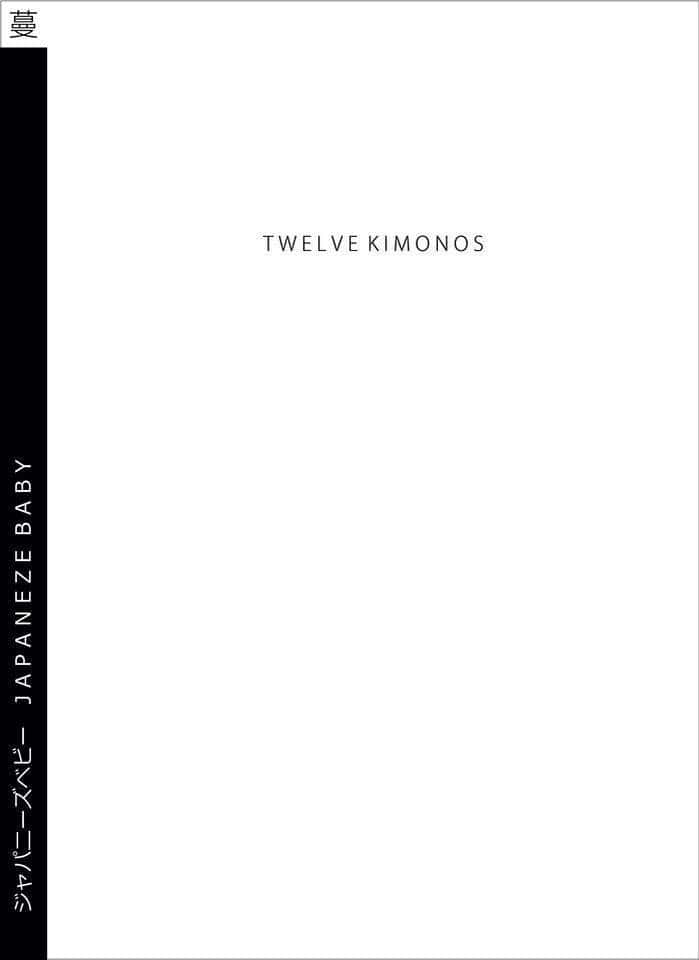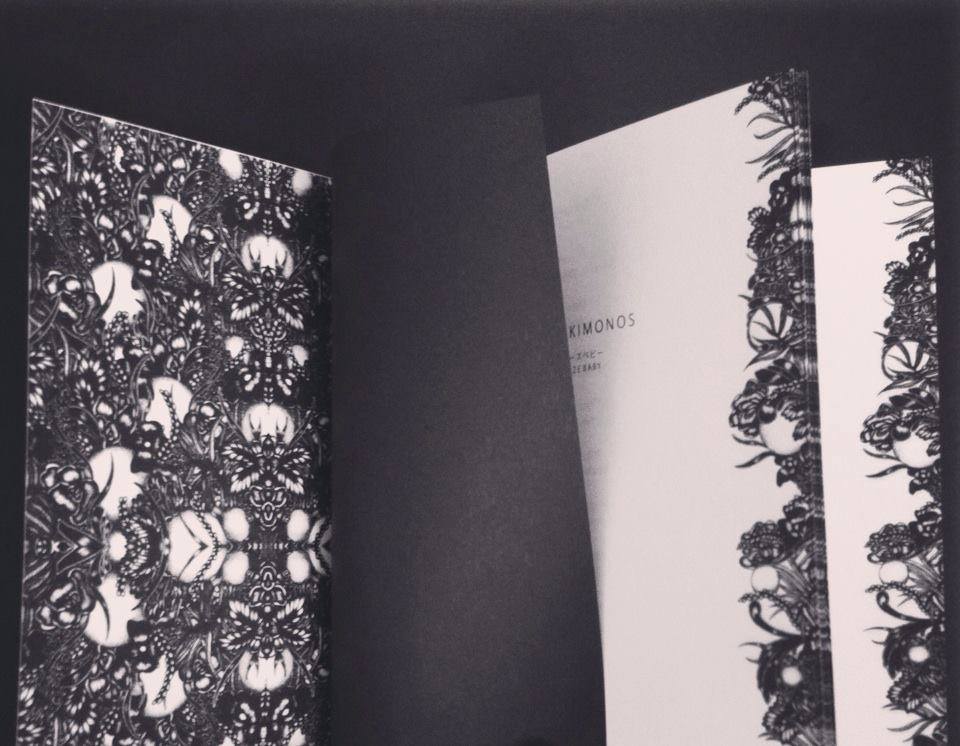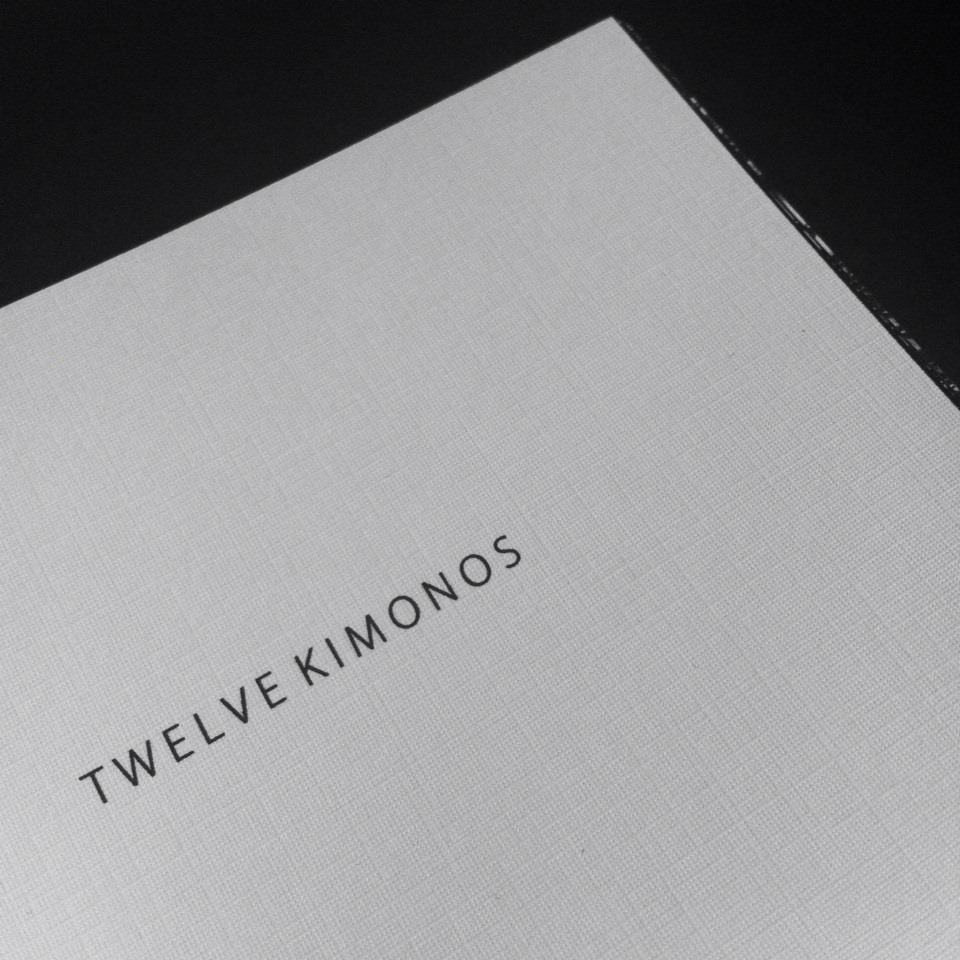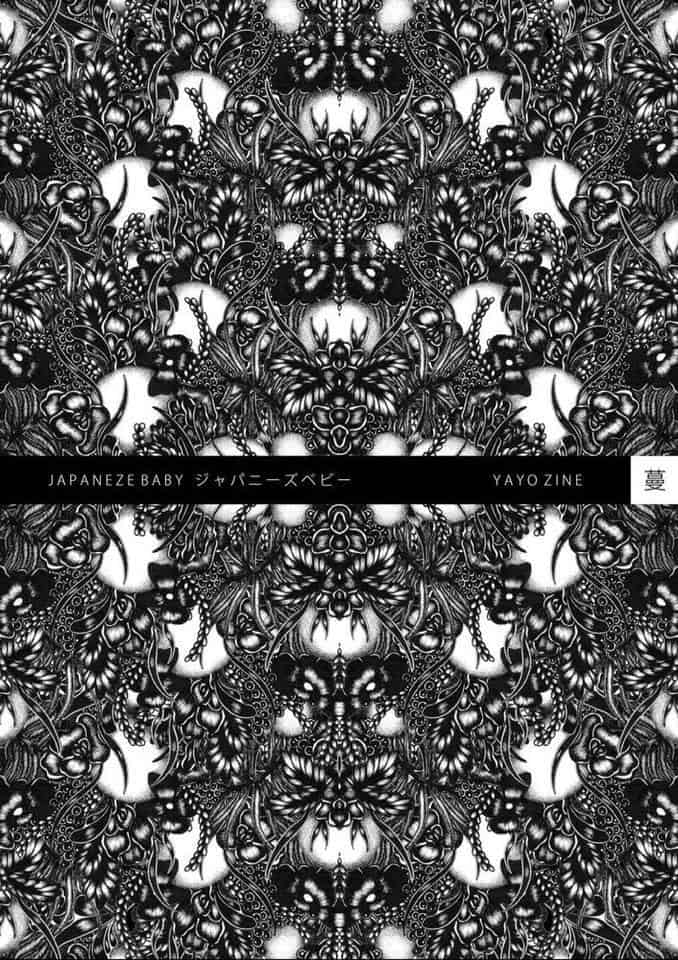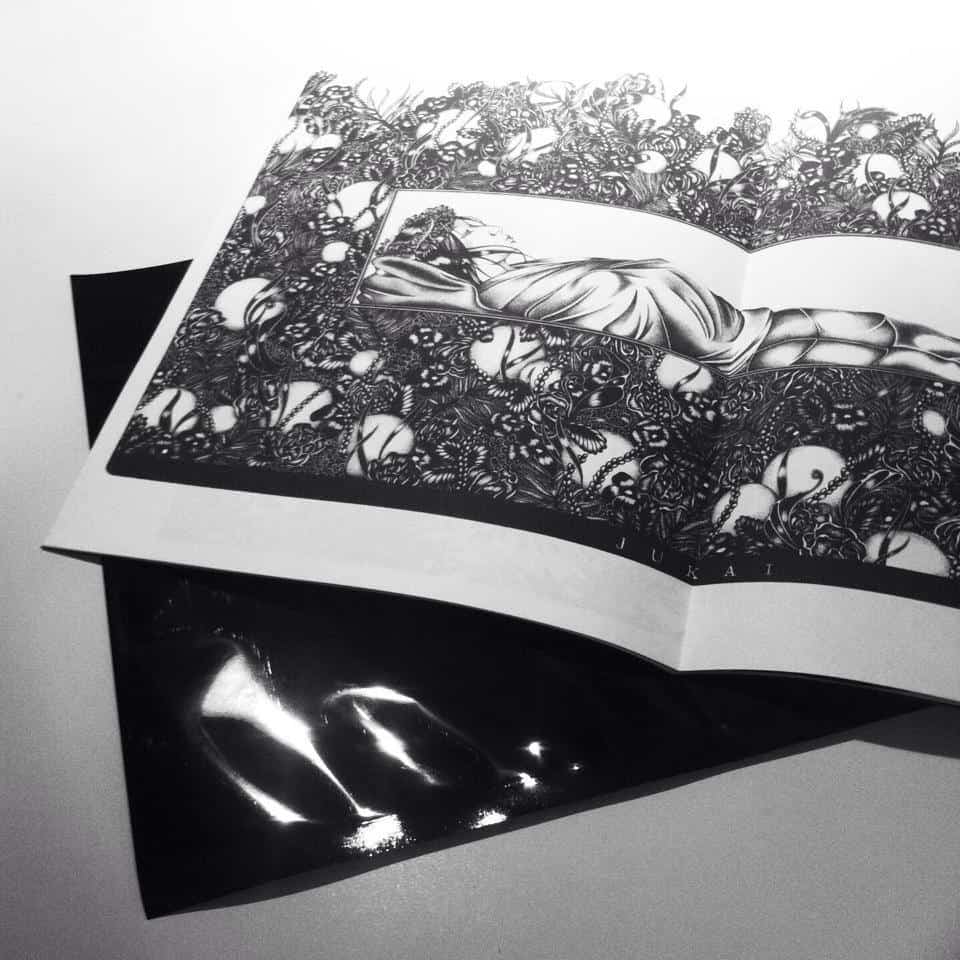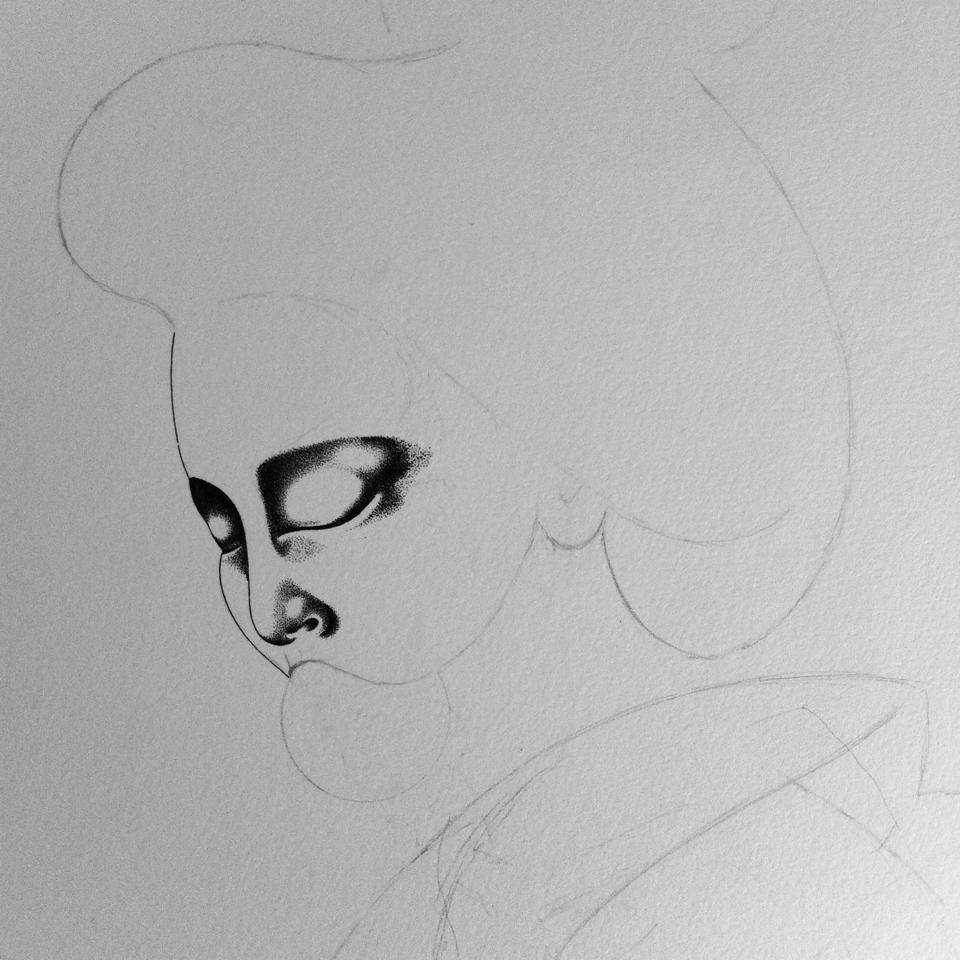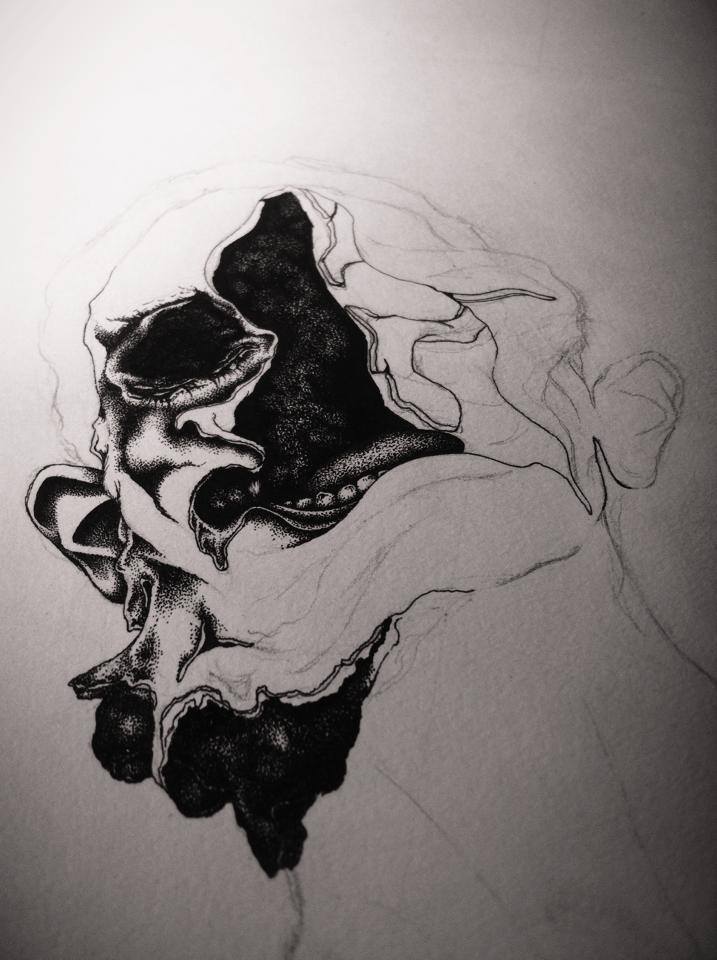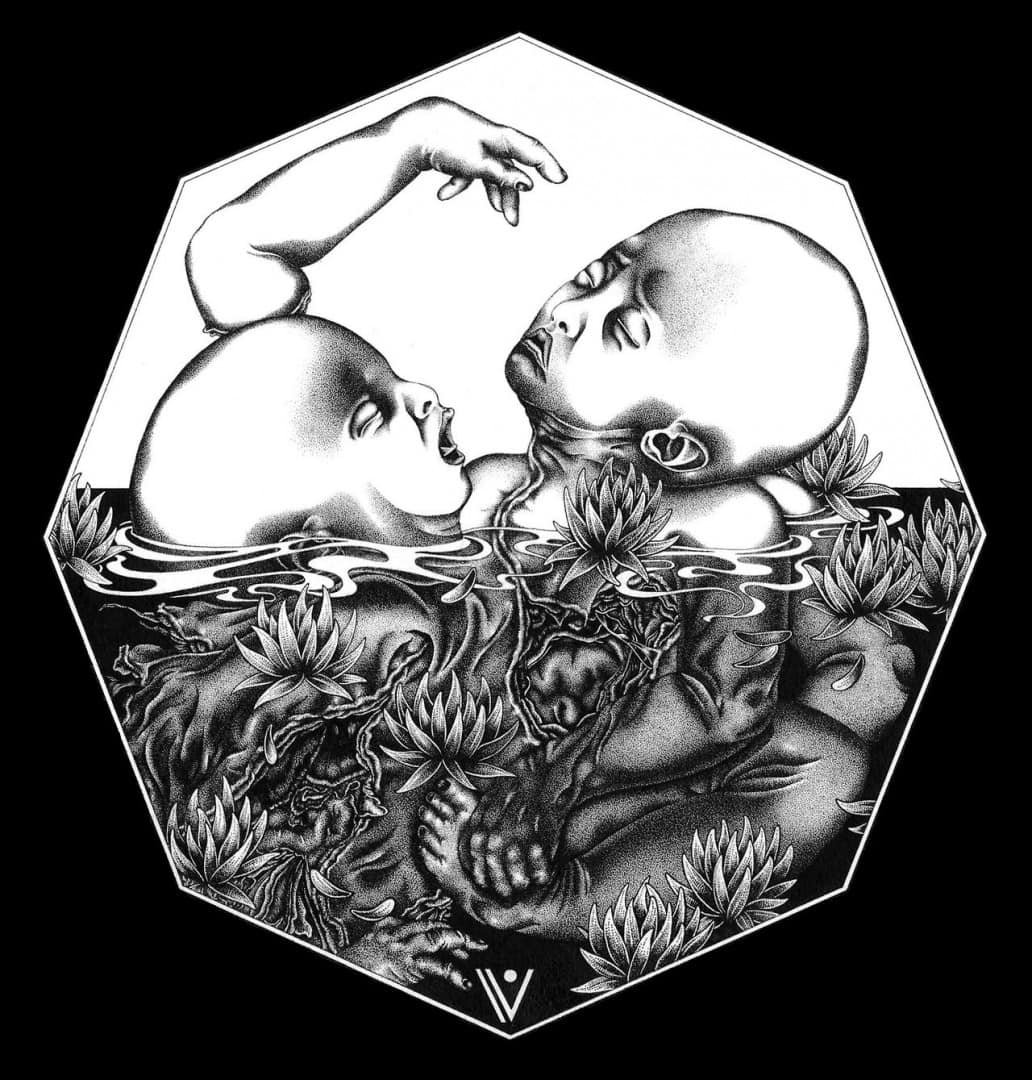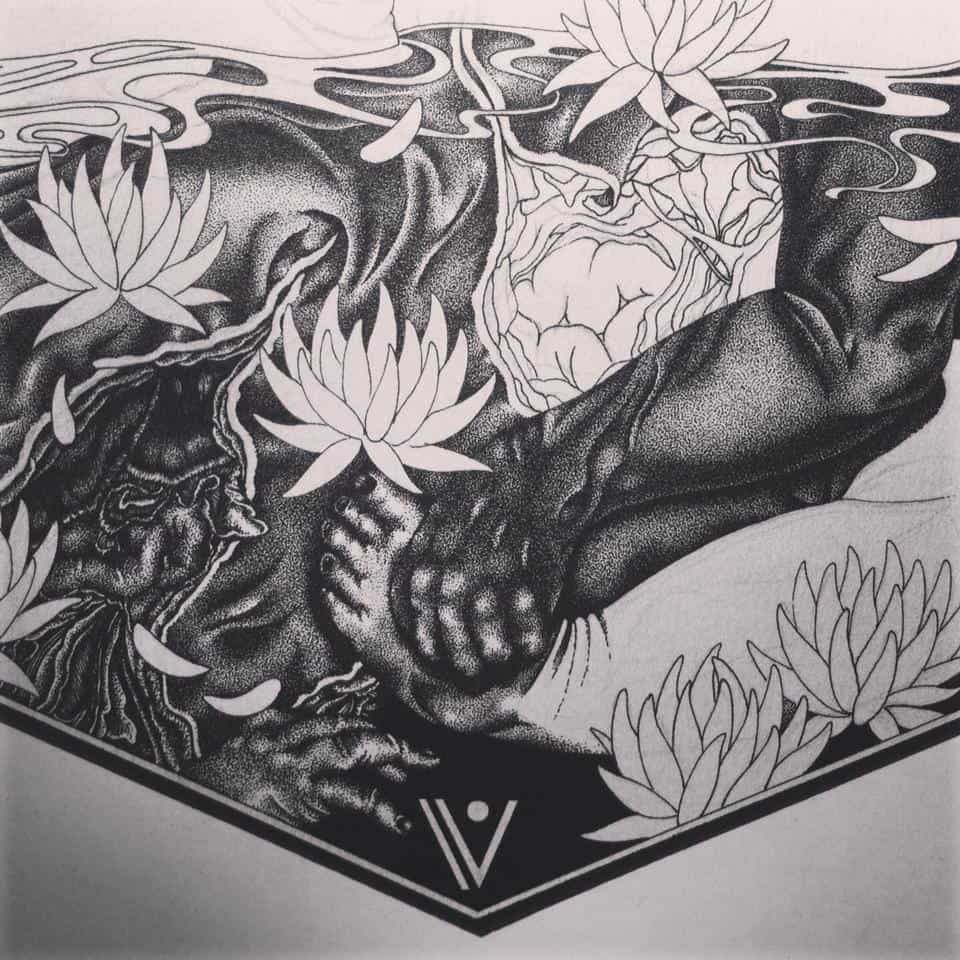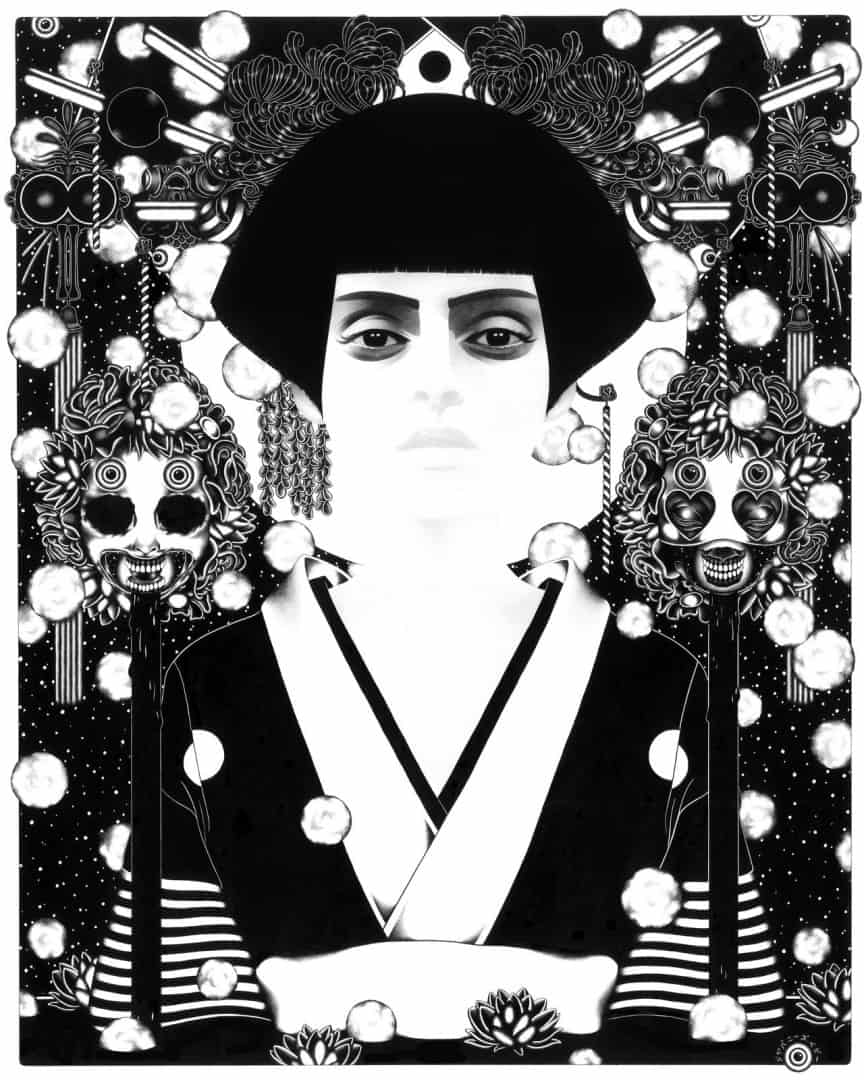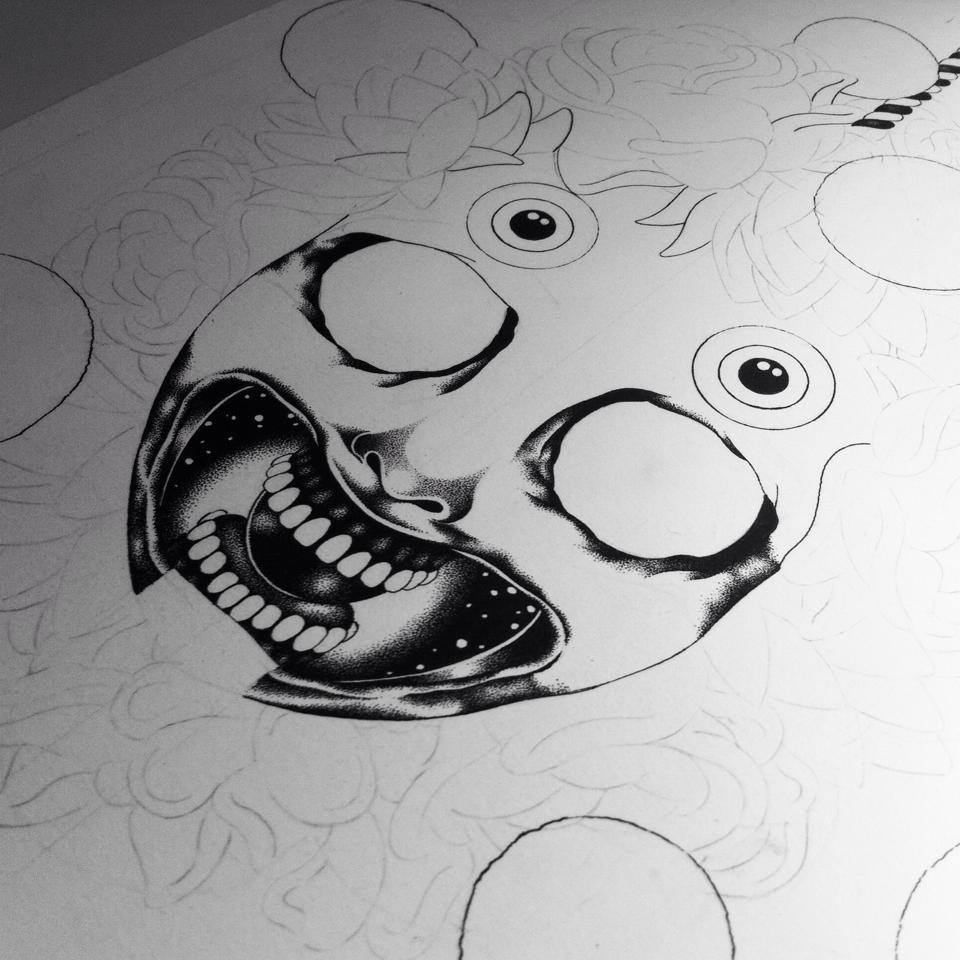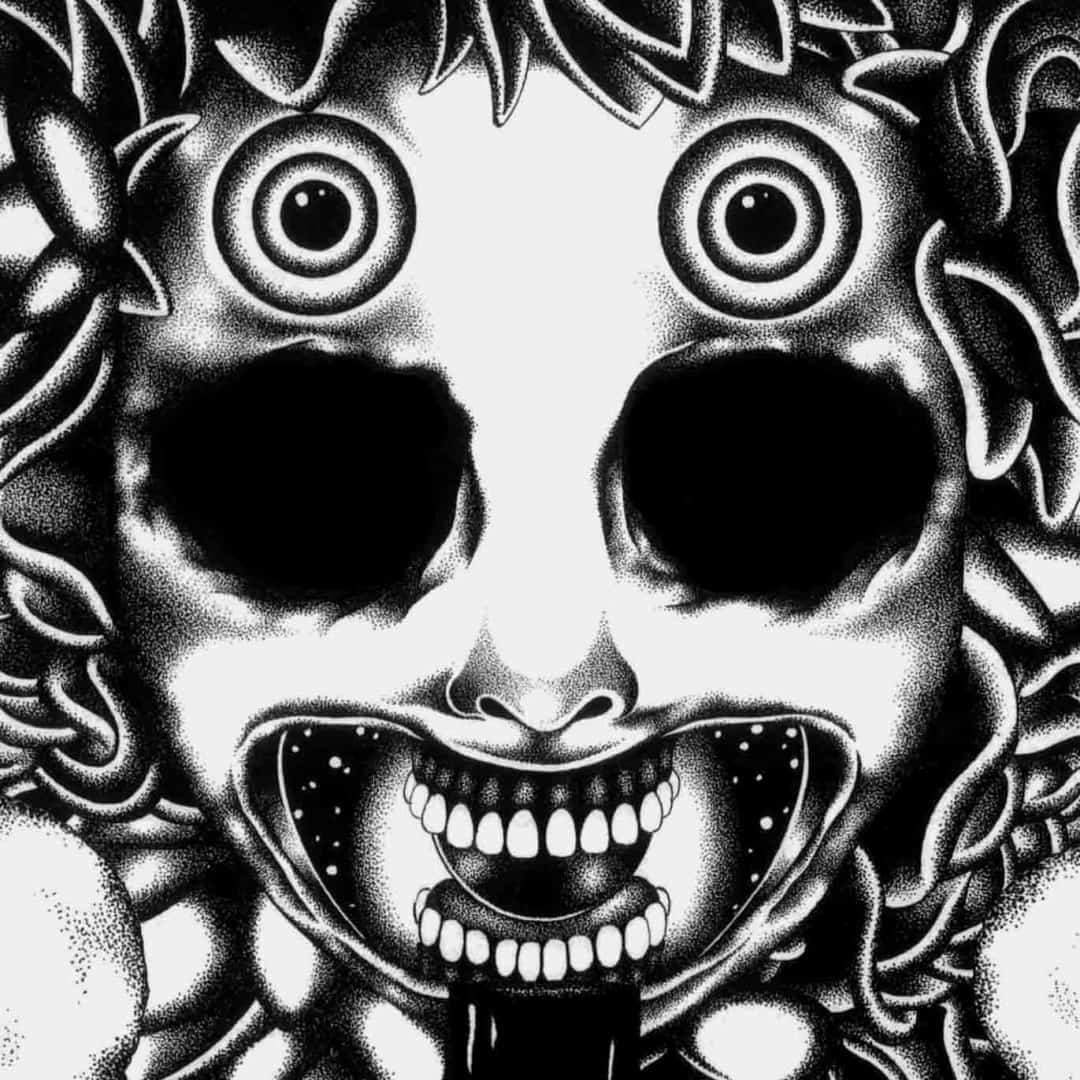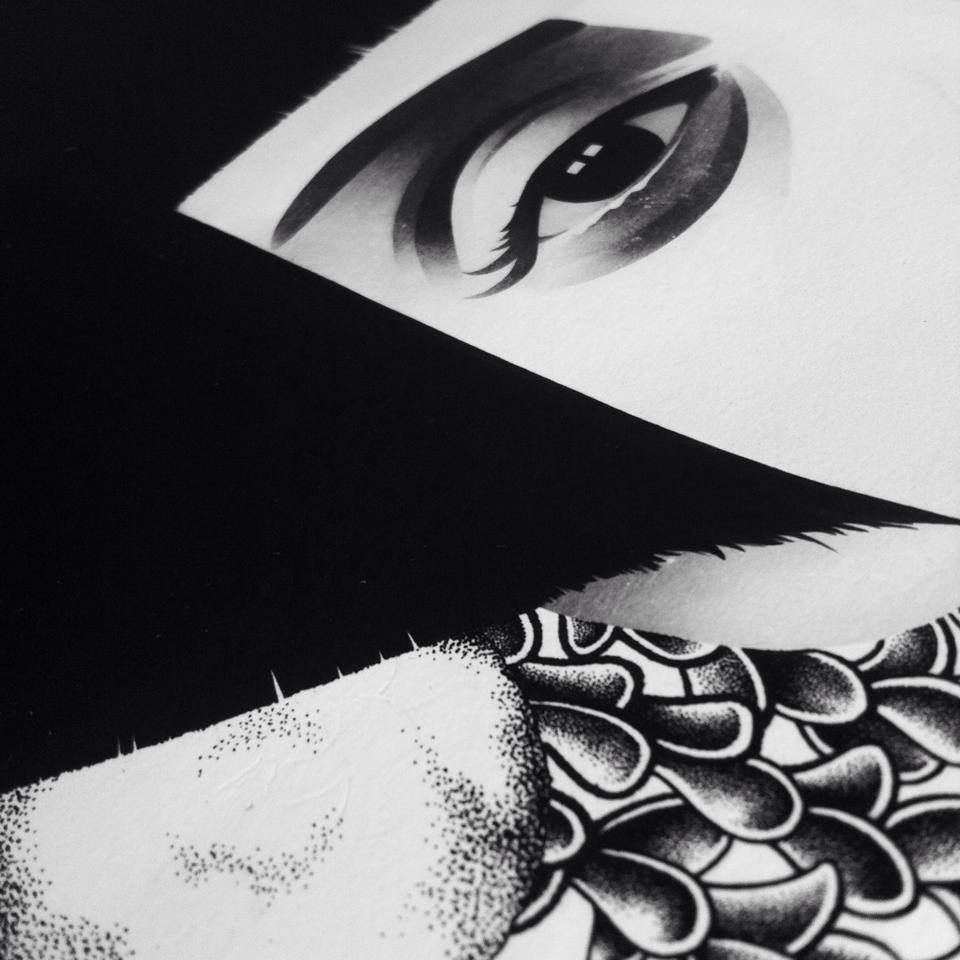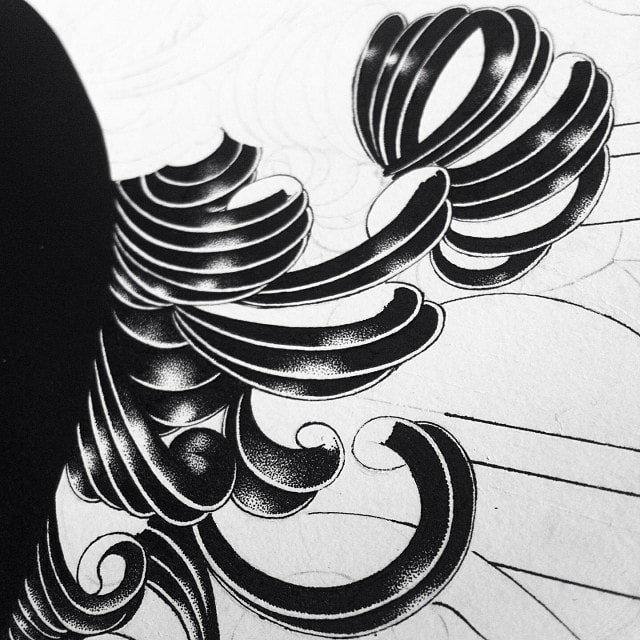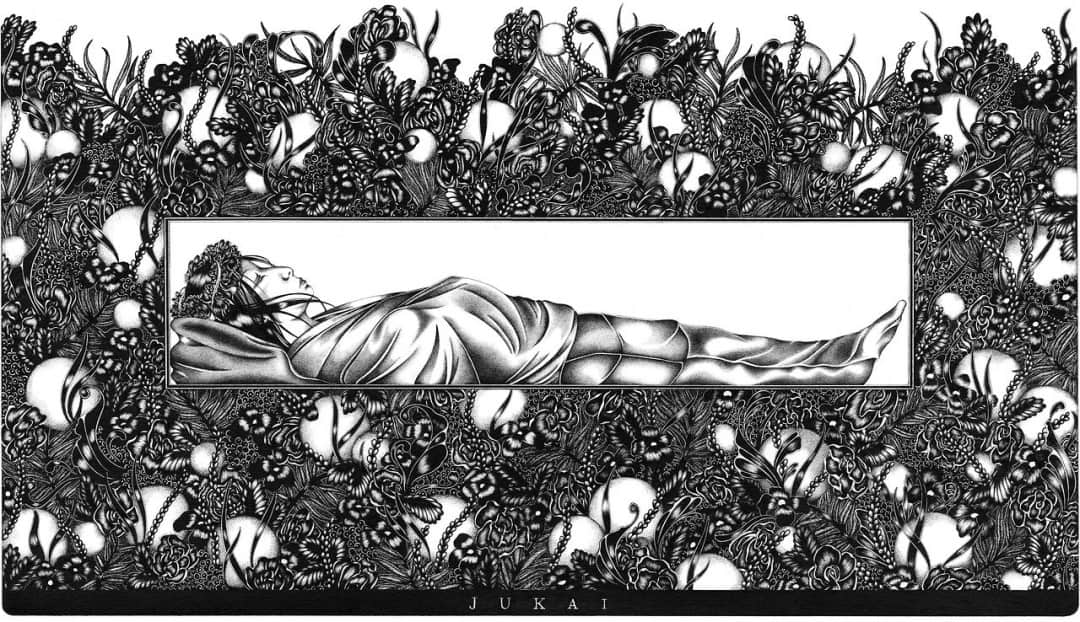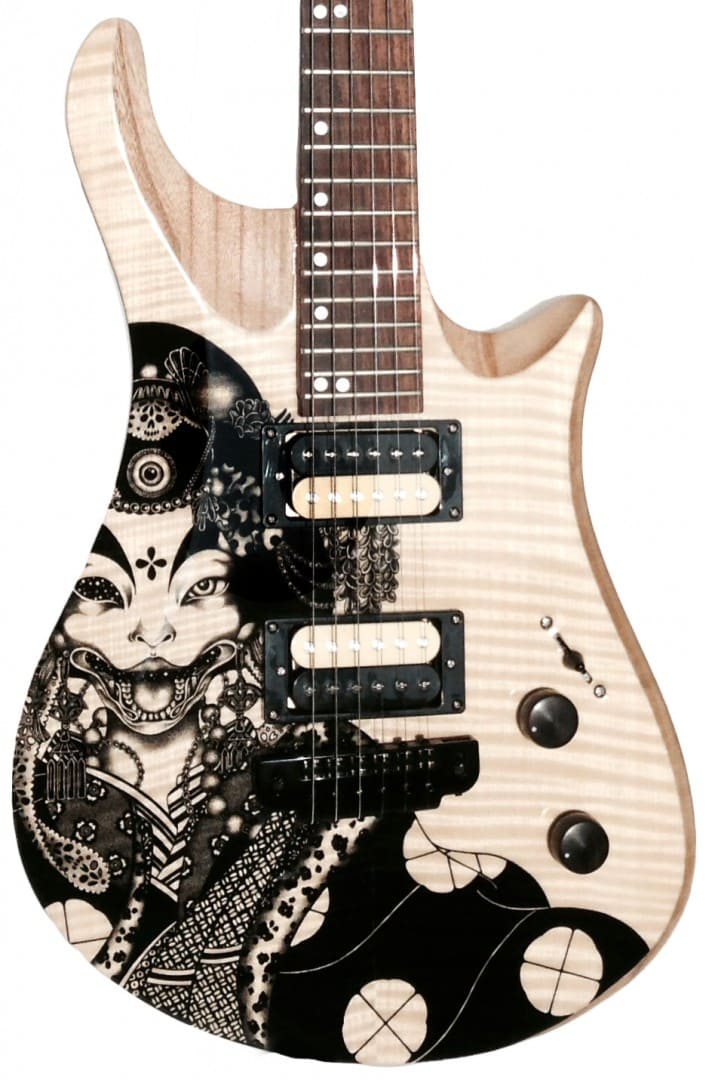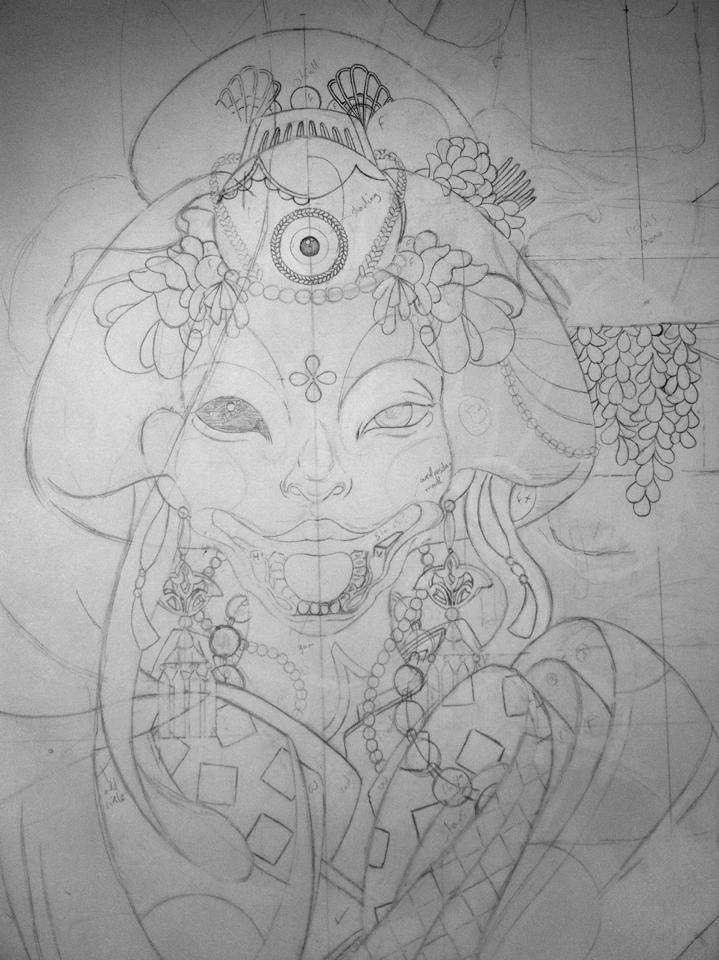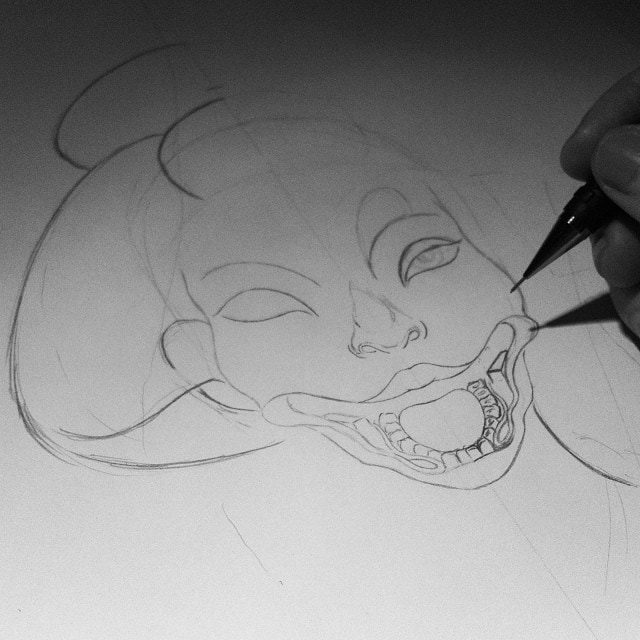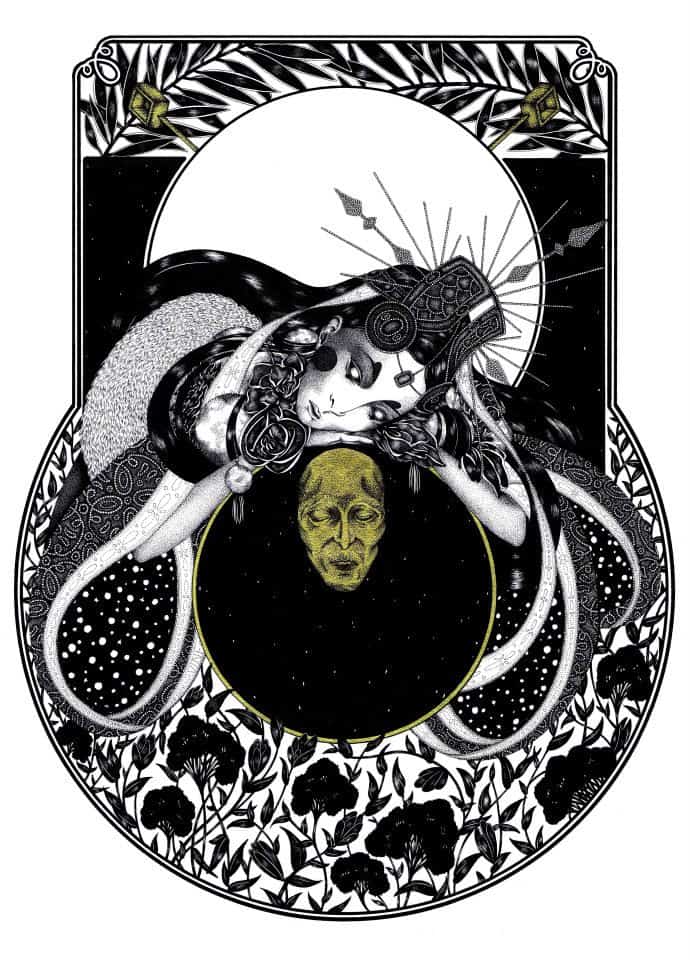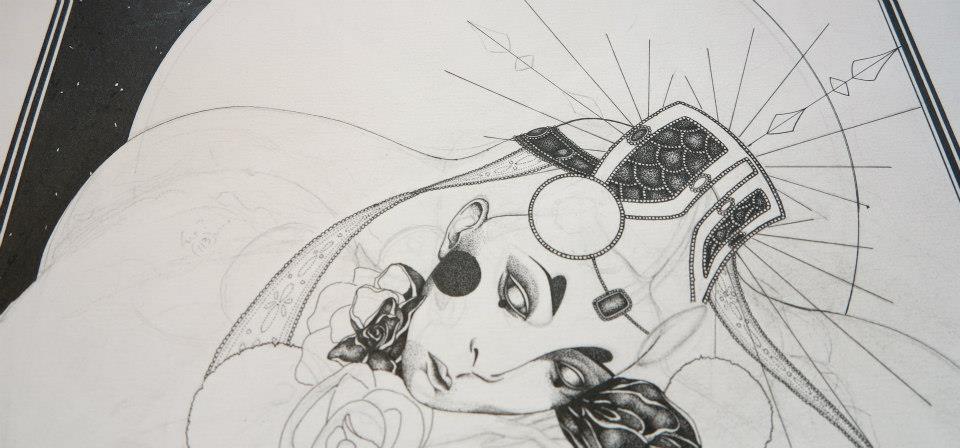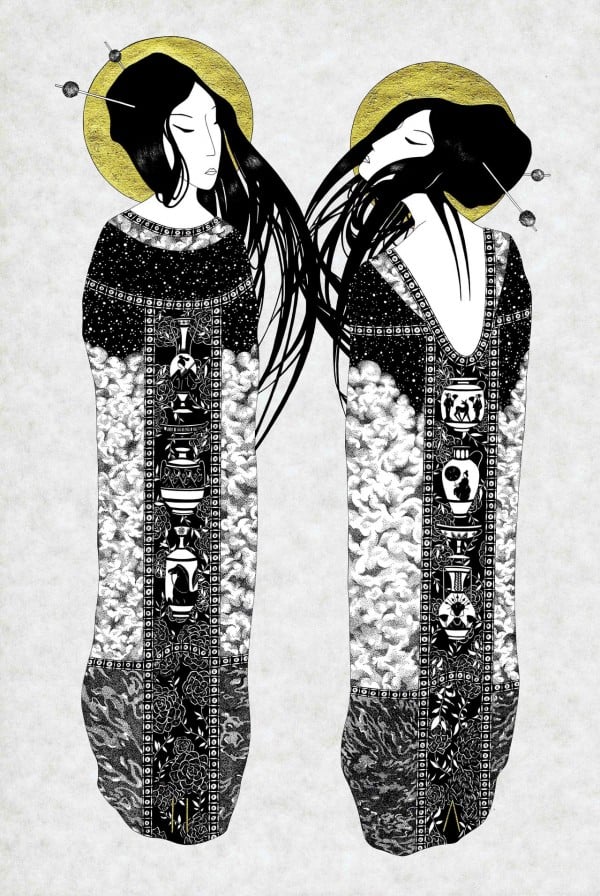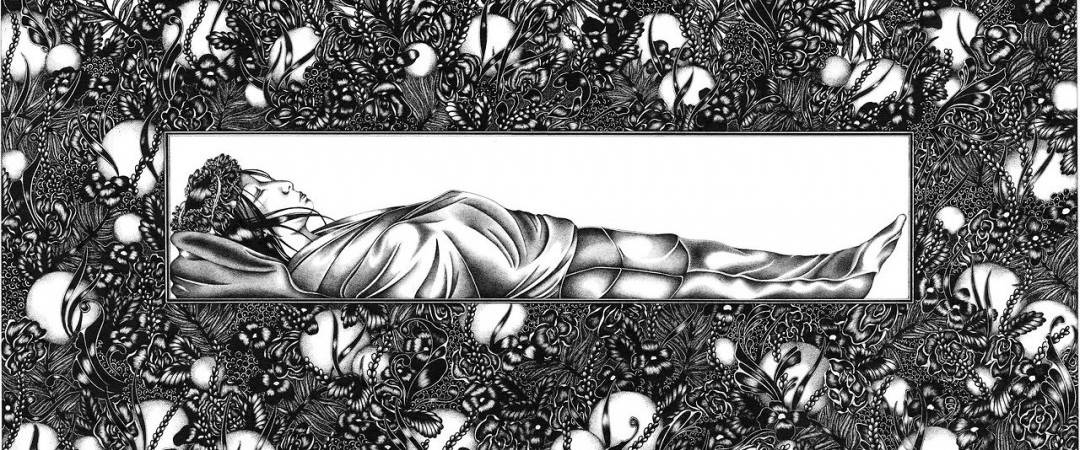
UK based artist Helen Vine works in horror. Her drawings are full of mysterious gore — an in your bones type of horror. She’s found a new darkness in her high contrast pen and ink drawings. The black goes deep, leaving the paper oil wet and dripping in Vine’s world of brilliant decay.
Vine surrounds her splayed and dying characters in patterns so lush they become labyrinth-like and epic. They pull you in and twist around you and when you’re inside, that’s when you see the blood. Her rivers into the underworld. The night sky and the universe.
The mythology behind the macabre death scenes Vine illustrates is of her own making. It’s an artist out to find peace in death, sorrow, and loss. Looking for answers. And no matter the weight of the subject, Vine always finds the beauty.
__________________________________________________________________________________________________________________________
What struck me first is your approach to one of your main subjects – death. Your displays of death are horrific. Morbid. But it’s interesting to stand back and look at your catalog of work as a whole and see the calmness in it.
With your style being so intricate you obviously spend a great amount of time with each piece, living in that space. There’s a real sense of an artist trying to understand the subject of death rather than using it for shock or irony. Is there something in the concept of death and decay that pulls you back to it?
Death is something I’ve always had a kind of romance with, thought endlessly about, researched, collected imagery of. It’s everything, and it’s all I really see in anything.
I’ve found it’s a place where I am, where my head always returns to. Is there anything more beautiful than the impermanence of life? It’s something in Japanese aesthetics I’m really interested in.
It’s like if I watch a gory film, it does nothing for me unless there is substance. What you don’t see can have so much more impact than visuals purely intended to shock. There has to be a soul.
I’m more interested in the stillness and creeping way of death; I like the little subtleties, a severed limb here and there. I would love to go full on gore on something, but it’d have to be in the right way. I always have ideas floating around; I know they will come out when the time is right.
There’s an incredible use of patterns in your work. ‘Happy Dispatch’ has elaborate patterns within the layout of a splayed woman. There’s a cosmic quality to it – stars above and clouds below. Without being direct, ‘Happy Dispatch’ feels to tell a story. There’s a sense of narrative in the pattern and composition.
Do you start with a sense of narrative when you begin or does it build? Does a drawing need to have a story within, or is that just something that me as the viewer wants to find in it?
When I’m drawing I’m thinking about the flow of things, the sounds — water trickling into rivers, trinkets jingling, heavy clouds billowing and churning; the ruffling of leaves and flowers, the silence under earth.
The only concept to me is to create an atmosphere with elements I find poetic; and death, suffering, sadness, all play well with these things, it gives them a power.
It’s just a basic desire in me, to draw, trying to understand techniques and how to use them. I am forever trying to emulate my idols in their level of artistry, learning the skills from them I want to possess myself.
I never know entirely how a drawing will turn out, and although in some ways I can be intentional and deliberate in my lines, although complex, the drawings are simple.There is no reason, just imagery. I’m all about creating a feeling, which I think communicates more than trying to explain anything. Explanations get lost. I can always remember what I was feeling or trying to gain technically from a drawing, it’s all escapism in practising the art.
Art is a strange thing to understand when looking for meaning. I’m content with only feeling awe for artists I admire. Like when I hear a song in another language, sometimes it’s nicer to imagine and just feel.
When starting a drawing are you sketching heavily to prepare? How much of the piece is locked in before you start drawing? With such strong patterns involved, is there any room for spontaneity?
I don’t really sketch or have sketchbooks. Even throughout school I always struggled to keep my work confined in one place. I still try sometimes, and I like the idea of having a book as a filled object itself, but I’ve learnt that I just don’t work that way.
I have folders and folders of loose bits of paper with messy thumbnails and notes on them, nothing ever planned out in detail. I like to keep the image pure for development later on, not to be tied to anything.
There is a lot of sketching on tracing paper throughout a final piece, for testing compositions then transferring, but rarely in preparation before I actually start the initial layout I write a lot of notes instead, or just words I like the sound of, or things I want to research. I’d like to get into the habit of keeping it all in one place though.
I try to pencil in as much of the layout of a drawing before inking. I spend a few days researching, collecting fresh references, and planning the layout. Then I’ll go over that process several times to make sure I haven’t missed anything out.
I’ll leave spaces I’m unsure of and work it in later, like patterns for clothing. I don’t ink in now until I’m sure its how I want it to be, as long as it takes. I’ve definitely learnt to stop myself from rushing in and have more patience with the foundations.
Sometimes I’ll start viscerally and the rest falls into place, and I’ll research along the way and the ideas build up. Other times I’ll have a clear picture in my head of what I want on paper, though the image isn’t always transferred from my brain to the page as I’d have liked, sometimes it’s better than I could have imagined, but sometimes I just can’t capture it.
Drawing can be a strange thing, the muse doesn’t always find you, but when it does, there is nothing like it. It’s a nice feeling when an idea just hits you.
Beauty is always at play in your drawings, but not in a direct way. Your figures are dominated by disfigurements, or in the case of your piece ‘Edo,’ skeletal. In ‘Vahyn’ the young woman has a cleft palate. The beauty is in your execution – for all of the decay and rivers of blood in ‘Yayo Epoch,’ it’s gorgeous.
You may depict gore, but your drawings are beautifully crafted. How aware are you of that balance between the morbid and beautiful? Is that something that you consider?
I think of beauty, and remember death. They are the same thing to me, it’s all connected. I am always aware of the transience of life, that in itself is beautiful.
To me having that mindset helps to channel the way I look at the things which have affected my work, not in disgust but with fascination, and so translate them with this balance. It is something that comes naturally through the mix of components and execution.
Stippling lends itself to the subject, and can have a velvet like effect I’ve found, which is perfect for drawing skin, and especially perfect for decaying skin, while keeping some kind of opulence, or at least I’d hope.
How luxurious it is to capture sadness and suffering on paper. A place to lay these thoughts, a place for my fantasies — mournful or manic, there is nothing more beautiful than a smiling corpse.
You recently started an online store with two zines and a tee shirt of ‘Yayo Epoch.’ What lead you to opening your own store rather than opting for an online store like Society6 or Redbubble that will handle the manufacturing and shipping of prints?
Launching my own products is something I’ve wanted to do for a long time. I wanted to learn the whole process for myself, and I prefer to buy other items from artists directly so I wanted to offer the same.
It’s nice to have people come straight to you and to be able to be more personal than a big company where you don’t see where the work is going.
Society6 is a great networking platform for artists, but for now I wanted to move away from it and concentrate on the things I wanted to put out to be more limited and exclusive. I also wanted a place where I could put out my writing, in my book ‘Twelve Kimonos,’ which has become another outlet for me.
I’m not a very verbal person and to me playing with letters and lines are closely connected — recording a thought, giving them a structure, although writing is much more instant. Sometimes you need the words, sometimes the art is not enough.
From your work in progress photos you post it seems like your only tools are pencil, pen, and paper. Is there no digital aspect of your work? Do you see tools like Photoshop or Illustrator ever playing a role in your work?
Digital art is something I’ve learnt to appreciate more over the last few years. It is a whole other talent. I’m in love with Hsiao Ron Cheng, who I had the pleasure of showing next to at Gauntlet Gallery recently. I thought she was a painter for a long time, her skill is beyond me.
I only use Photoshop for scanning in and matching up large drawings. They always look so different on screen, it’s like I can really take a step back and see the whole picture, sometimes – It’s frustrating to me to not be able to see my images for the first time in their entirety.
I love the feeling of having one original piece you can hold in your hands, run your fingers across the surface and feel the texture of the ink. I like to get across the hand drawn element in the progress shots as an insight of how a piece takes form, and it’s nice to share as the process can be a lonely one at times, though obviously one I ultimately adore. I love to draw. I don’t know why I’d ever put the pen down.
How large are you working at? Your work almost demands to be seen on a large scale. Are you limited to a certain size due to the nature of your technique? Does the amount of time a piece will take ever stop you from starting a piece?
I don’t really like to limit myself too much in terms of size or even surface. I don’t feel that I’m bound to many restrictions. It really depends on the complexities and arrangements of a drawing, and I’ll take those things into consideration so I don’t go in over my head. It’s a subconscious decision that is really just artistic common sense.
‘Cixi’ was 24 x 30″, so about A1 size, which was honestly just crazy. But it had a lot of small elements I could focus on one at a time with lots of space in between. The bodies in ‘The Blood of Asia,’ at 8″ x 8″, would’ve taken me years on a large scale as nearly the whole thing was stippled.
It’s a time consuming technique which at times can be a little physically and mentally painful, especially when you have a bit of an obsessive nature with these things. It still feels new to me every time, and I’m teaching myself with every new piece how to better it in my work.
For every large drawing I’ll make a few smaller pieces in between for some head space. A vision has to be strong to work for so long on one thing, but I find there is no room for impatience when bringing to life a vision. The work is always intense, but when I’m drawing I always forget about time anyway.
For your collaboration with Ruben Ireland, did you two have any discussions on how to proceed? Any sort of goal in mind? Was it a back and forth situation, or did you get something from him and took it from there?
We had talked the year before about collaborating so I was more than excited when he asked me to work with him on a piece for his show, ‘Out of Body.’
We shared a few ideas through messages, the theme was loose and in Ruben’s trust I was free to take his figure to wherever I could imagine. Ruben’s images are always so gently powerful, so I wanted to compliment his sublimity and try to seamlessly combine our styles.
I had a lot built up inside me waiting to just bleed out in ink on Ruben’s digital print. I’ve noticed lately my excitement for something usually mutates my characters into a manic state, which in turn I feel created a sort of playful necromancy on ‘Cixi.’The scale was insane, and she always mesmerizes me a little. I really loved working on that piece.
I saw the print of ‘Cixi,’ your collaboration with Ruben Ireland at the ‘Out of Body’ show at Gauntlet Gallery and a .jpeg on a computer monitor doesn’t do it justice. I heard the original drawing has more detail in the patterns that the print can’t reproduce. What do you see as the proper end product for your work – the original or a print? Do you sell your originals?
For now I like to keep my originals. In the future things may change but to me they are more valuable as references than to let go of right now. Nothing compares to seeing an original in the flesh.
The blue tint the stippling effect gives to the black ink, the depth and softness of the dots — they are closely replicated in print, but not so much on screen.
I was recently given the opportunity to work on a couple of hand carved guitars for Marlow Guitars who are based in London, and I’m working on the second one now. So those are the only original pieces I have available now and intend to for some time. I do miss my ‘Dahlia Deluxe’ guitar quite a lot though.
As far as printmaking goes — have you tried other mediums outside of giclee prints for your drawings – woodblock, etching, or silkscreen?
I did try out screen printing a couple of years ago, but I’d rather spend the time drawing and have the professionals do a better job. It’s not something I’m too interested in developing myself and I was always stubborn to try it in school.
My work is often compared to Japanese woodblock prints so it would be cool to see that happen, though I cant say if I’ll ever pursue it.
I’d like to experiment with other mediums in my work, but for now I’m enjoying what I’m producing with ink. I really just love everything to do with ink, from it’s history in art down to filling my own cartridges; although I found the work of Kazuhiro Hori a while ago which stunned me and really makes me want to try out painting and adding more colour to my work, but there is so much to master in even just one medium.
Your style is so direct and bold – well defined. Did your school help shape it or was it fully formed before you began?
I was looking through my old school portfolios the other day, which was something I’d avoided for a long time, as apart from the life experience, I don’t know how much I actually learnt from school. It was sad to look back on it, I left feeling very unprepared. The years since university are the ones most valuable to me, where I’ve progressed the most. I work better alone.
The only thing I miss about school is that I don’t really get to show my work to anyone in real life anymore. I don’t know how much of a memory of me really exists anymore outside of my drawings, I just kind of float about on my own these days.
__________________________________________________________________________________________________________________________
For more work from Helen Vine follow these handy links —
